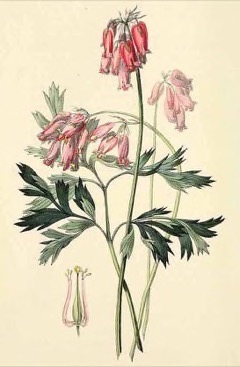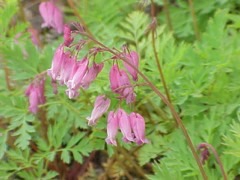 |
|
edibleplants.org |
 |
| Kurt Stüber wikimedia.org |
Translate this page:
Summary
Physical Characteristics

 Dicentra eximia is a PERENNIAL growing to 0.4 m (1ft 4in) by 0.4 m (1ft 4in) at a medium rate.
Dicentra eximia is a PERENNIAL growing to 0.4 m (1ft 4in) by 0.4 m (1ft 4in) at a medium rate.
See above for USDA hardiness. It is hardy to UK zone 4. The flowers are pollinated by Birds, Bees, Insects.
It is noted for attracting wildlife.
Suitable for: light (sandy), medium (loamy) and heavy (clay) soils, prefers well-drained soil and can grow in nutritionally poor soil. Suitable pH: mildly acid and neutral soils. It can grow in full shade (deep woodland) or semi-shade (light woodland). It prefers moist soil.
UK Hardiness Map
US Hardiness Map
Synonyms
Bicuculla eximia (Ker Gawl.) Millsp. Bikukulla eximia (Ker Gawl.) Druce. Capnorchis eximia (Ker Gawl.) Planch. Capnorchis eximia (Ker Gawl.) Kuntze. Corydalis eximia (Ker Gawl.). Diclytra eximia (Ker Gawl.) DC. Dielytra eximia (Ker Gawl.) G.Don. Eucapnos eximius (Ker Gawl.) Bernh. Fumaria eximia Ker Gawl. Fumaria formosa Poir.
Plant Habitats
Edible Uses
References More on Edible Uses
Medicinal Uses
Plants For A Future can not take any responsibility for any adverse effects from the use of plants. Always seek advice from a professional before using a plant medicinally.
None known
References More on Medicinal Uses
The Bookshop: Edible Plant Books
Our Latest books on Perennial Plants For Food Forests and Permaculture Gardens in paperback or digital formats.

Edible Tropical Plants
Food Forest Plants for Hotter Conditions: 250+ Plants For Tropical Food Forests & Permaculture Gardens.
More

Edible Temperate Plants
Plants for Your Food Forest: 500 Plants for Temperate Food Forests & Permaculture Gardens.
More

More Books
PFAF have eight books available in paperback and digital formats. Browse the shop for more information.
Shop Now
Other Uses
Groundcover: A medium density moderately good groundcover for shade and semi-shade. Colonizes very slowly through rhizomes. Wildlife Food: The nectar is sought by hummingbirds. Wildlife Habitat: Provides cover for small wildlife. Insectory: Attracts beneficial insects [318-1]. Good companion plants include; Jacobs Ladder and Wild Columbine. Cut Flowers. Ornamental: Ornamental foliage and flowers. The foliage is deeply cut and fern-like, and does not die back like the common bleeding heart. Flowers are shades of pink and white and heart shaped [318-1].
Special Uses
Food Forest Ground Cover
References More on Other Uses
Cultivation details
An herbaceous perennial growing well in semi-shade. USDA Hardiness Zones: 3 - 9. Soil pH: 5.5 - 7.0. Life Span: Long-Lived Perennial. Stand Persistence: Long. Form: Upright. Texture: Fine. Sun: Partial Shade, Shade. Soil Type: Loamy, Silty. Soil Moisture: Moderate. Minimum Root Depth: 6 inches (15cm). Root Type: Rhizome, Fibrous Shallow. Fungal Types: Endomycorrhizal. Seasonal Interest: Summer. Will tolerate full sun if given sufficient moisture. Requires rich well-drained soil. Flowering may stop in areas with very hot weather. Will not go dormant in midsummer like the Common Bleeding Heart as long as the soil is kept moist. Tolerant of proximity to black walnut trees. Fruit Type: Capsule. Flower Color: Pink, Red, White. Drought: Sensitive. Flood: Intolerant. Salt: Intolerant. Soil Compaction: Sensitive. Mowing: Intolerant. Cold Injury: Infrequent. Disease Issues: Minor. Insect/Pest Damage: Minor. Animal Damage: Deer, Rabbits. Growing Season: Cool. Bloom Time: Late Spring - Early Fall. Fruit Time: Fall - Winter [318-1]. For polyculture design as well as the above-ground architecture (form - tree, shrub etc. and size shown above) information on the habit and root pattern is also useful and given here if available. The plant growth habit is a clumper with limited spread [1-2]. The root pattern is rhizomatous with underground stems sending roots and shoots along their length [1-2]. The root pattern is fibrous dividing into a large number of fine roots [1-2].
References Carbon Farming Information and Carbon Sequestration Information
Temperature Converter
Type a value in the Celsius field to convert the value to Fahrenheit:
Fahrenheit:
The PFAF Bookshop
Plants For A Future have a number of books available in paperback and digital form. Book titles include Edible Plants, Edible Perennials, Edible Trees,Edible Shrubs, Woodland Gardening, and Temperate Food Forest Plants. Our new book is Food Forest Plants For Hotter Conditions (Tropical and Sub-Tropical).
Shop Now
Plant Propagation
Other Names
If available other names are mentioned here
Wild bleeding-heart, Fringed bleeding-heart, turkey-corn, Fernleaf Bleeding Heart
Native Range
NORTHERN AMERICA: United States, New Jersey (north), Pennsylvania, West Virginia, Maryland, North Carolina (west), Tennessee, Virginia (west),
Weed Potential
Right plant wrong place. We are currently updating this section.
Please note that a plant may be invasive in one area but may not in your area so it's worth checking.
None Known
Conservation Status
IUCN Red List of Threatened Plants Status :

Growth: S = slow M = medium F = fast. Soil: L = light (sandy) M = medium H = heavy (clay). pH: A = acid N = neutral B = basic (alkaline). Shade: F = full shade S = semi-shade N = no shade. Moisture: D = dry M = Moist We = wet Wa = water.
Now available:
Food Forest Plants for Mediterranean Conditions
350+ Perennial Plants For Mediterranean and Drier Food Forests and Permaculture Gardens.
[Paperback and eBook]
This is the third in Plants For A Future's series of plant guides for food forests tailored to
specific climate zones. Following volumes on temperate and tropical ecosystems, this book focuses
on species suited to Mediterranean conditions—regions with hot, dry summers and cool, wet winters,
often facing the added challenge of climate change.
Read More
Expert comment
Author
(Ker Gawl.) Torr.
Botanical References
Links / References
For a list of references used on this page please go here
Readers comment
| Add a comment |
|
If you have important information about this plant that may help other users please add a comment or link below. Only comments or links that are felt to be directly relevant to a plant will be included. If you think a comment/link or information contained on this page is inaccurate or misleading we would welcome your feedback at [email protected]. If you have questions about a plant please use the Forum on this website as we do not have the resources to answer questions ourselves.
* Please note: the comments by website users are not necessarily those held by PFAF and may give misleading or inaccurate information.
To leave a comment please Register or login here All comments need to be approved so will not appear immediately.
|
Subject : Dicentra eximia
|
|
|
|